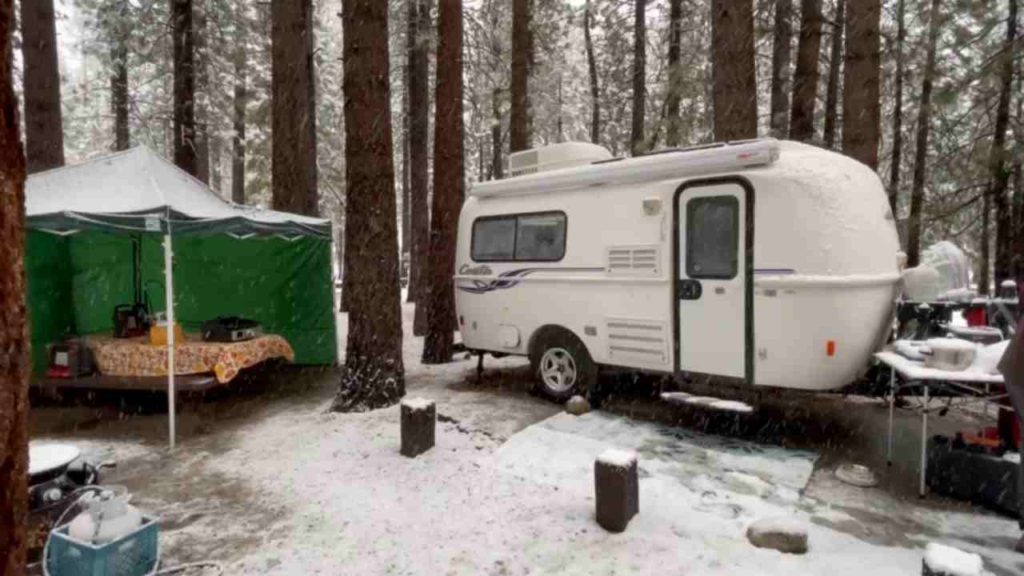
Camping on the shoulder season is a different experience. Kids have gone back to school, summer is over, and, it’s quiet. There’s nothing better than the serenity of off-season camping. On the flip side, the weather is now cooler, or maybe even cold. So, how cold is too cold to go camping?
It’s too cold to go RV camping when the nighttime temperature reaches 15° F (-9° C) and daytime temperatures do not reach more than 35° F (-2° C). However, you’ll need to make some special preparations to your RV to camp at temperatures that low. Here are some considerations for your cold-weather journey.
Can RVs Handle Cold Weather?
Some RVs are better than others at handling cold weather. Your best bet for a cold-weather trailer is a multi-season camper. Since RVs can be sold anywhere, most manufacturers do not advertise having the ability for the RV to be utilized all four seasons, since a 4-season camper in Alaska would be different than a 4-season camper in Texas. If you do see a camper that is touted as having four seasons pay close attention to the amenities.
RV Features for Cold Weather
Here are some features of a multi-season camper:
- High-Density Foam Wall Insulation
- Thermal Pane Windows
- Heated Holding Tanks
- Enclosed or Insulated Holding Tanks
- Interior Heat
- Ducted Heat
- Insulated Water Bay
It’s important to note that not all multi-season RVs have these features. Check the specific RV specifications to determine features.
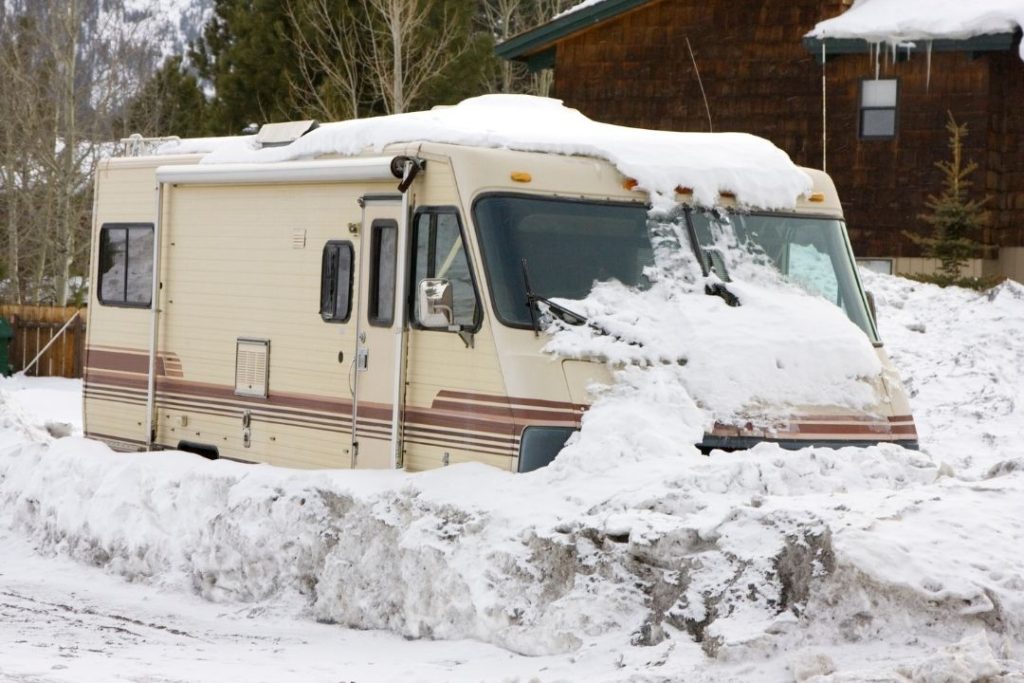
Can You Use an RV in Cold Weather?
Many RVs are designed for cold weather. And, with special considerations, even RVs that are not specifically designed for cold weather can be used with prior preparation.
Which RVs are Best for Colder Weather?
Here are some RVs that are best suited for cold-weather conditions:
- Bigfoot RV
- Escape Trailer
- Oliver Travel Trailer
- Northwood Arctic Fox Travel Trailers
- Keystone Montana Fifth Wheel
- Forest River Arctic Wolf Fifth Wheels
- Outdoors RV Timber Ridge Mountain Series Travel Trailer
- Northwood Nash Trailers
- Lance Travel Trailers
If you don’t have one of these trailers and are not planning on getting one, you can still camp in your RV in cold weather with some preparation.
How Cold Does it Have to Be For RV Pipes to Freeze?
Freezing temperatures (32° F, 0° F) in an unheated RV can cause pipes to freeze. There is also the potential for pipes to freeze even in a heated RV when temperatures do not rise above (32° F, and 0° F) for 1-2 days. Multi-season RVs can sustain much lower temperatures before pipes freeze because they have heated, insulated tanks. However, the hose that is connected to the campground faucet is at risk of freezing at temperatures below (32° F, and 0° F), as is the faucet.
How Do You Travel With an RV in the Winter?
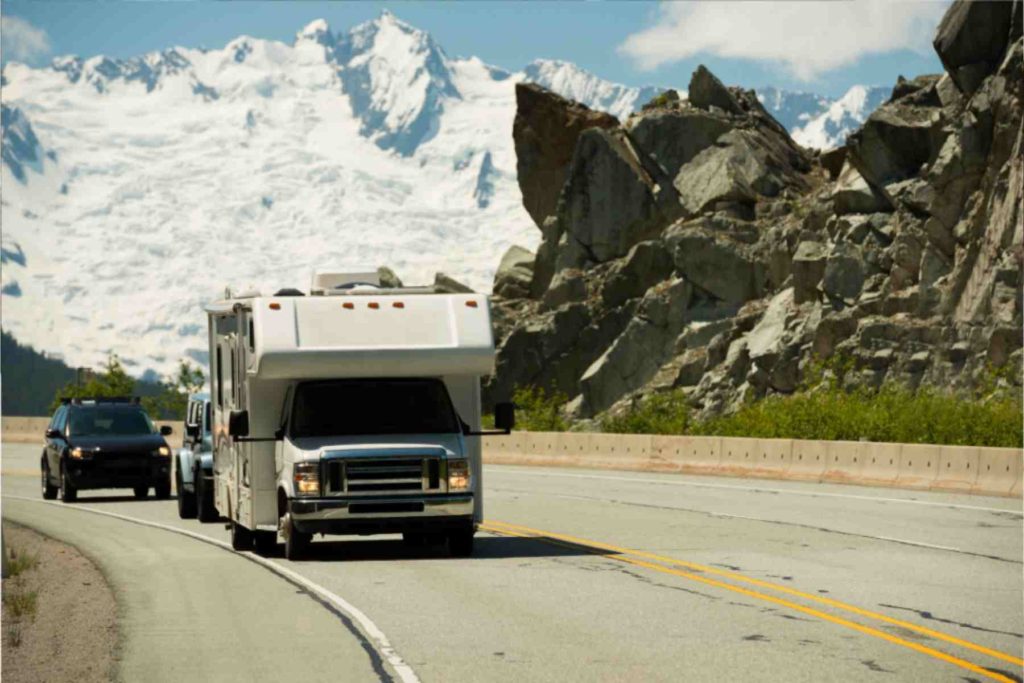
There are some special preparations to get your RV ready for winter travel:
- Check the caulking/seals
- Check your RV battery
- Check your tires (pressure, tread, age)
- Check the engine antifreeze
- Check all lights
- Check wiper blades and washer fluid
- check heater/defroster in the vehicle
- extra food/water and blankets
- Extra Food for Pets
- Appropriate clothing/footwear
- Paper maps
- A responsible person knows where you’re going
- Check weather conditions
- Check propane levels
- Tire Chains where appropriate
Check the Caulking/Seals
Any seal on the RV is a place where cold air can get in. Check the caulking on the roof and any seals on the roof and outside walls. Be sure to check windows and vents. Repair any areas where the caulking is cracked or loose. For more information, see Common Problems with Travel Trailers.
Check your RV Battery
Check the water in your battery, make sure the posts are not corroded, and that the battery is less than 5 years old. Add water if necessary. Clean corroded posts with a baking soda water mixture, making sure the baking soda does not get inside the battery cells. Replace batteries older than 5 years.
Check Your Tires
Check the pressure on your tires to make sure that it meets manufacturer specifications. Check the tread depth. The best way to check the tread depth is with a tire tread depth gauge. You can pick one up for less than $10.00. Replace the tires if the tread is low.
Inspect the tires visually, both the tread and sidewalls, for damage, rot, or disintegration.
Check the age of the tires. If the tires are more than 5 years old, have them replaced.
Check the Engine Antifreeze
Check the engine antifreeze levels and top of if necessary.
Check All Lights
Check all the exterior lights (brake lights, turn signals, etc.) to insure proper function.
Check Wiper Blades and Washer Fluid
Make sure the wiper blades are properly functioning. If you plan on camping in areas with freezing temperatures, consider using a de-icer windshield washer fluid.
Check Heater/Defroster in the Vehicle
Make sure your heater and defroster are functioning in the cab or tow vehicle.
Extra Food/Water and Blankets
Make sure you have extra food, water, and blankets in case of an emergency. Pack extra food for your pets.
Appropriate Clothing/Footwear
If you run into a problem with your RV, you don’t want to be digging for appropriate clothing and footwear. Have those items available in case you need to change a flat tire, etc.
Paper maps

Paper maps are always a good idea, but especially so when traveling in cold weather. A cell phone signal is not guaranteed and, if you get lost in the cold or snow, a fun trip can turn into a big problem. Make sure a responsible person knows your itinerary. I always make sure that someone knows where we are going for shorter trips and has our full itinerary for long trips.
Check Weather Conditions
Check the weather conditions before you leave and have a way to check them during the trip.
Check Propane Levels
Make sure your propane tanks are topped off. Have a way to check propane tanks while you are camping. There are a few different devices that check propane levels. This Propane Tank Gas Level Indicator or this one.
Tire Chains Where Appropriate
If you are heading into an area that requires tire chains, like Yosemite National Park, be sure to have them in your RV before you leave.
What are Some Winter Camping Must-Haves?
Here are some winter camping must-haves that will make your camping stay more comfortable:
- RV Heater
- Moisture Absorbers/Dehumidifier
- Vent/Skylight Insulation
- Reflective or Insulative Window Coverings and/or Heavy Drapes
- Insulative Foam Board
- Floor Insulation and RV Skirting
- Electric Blankets/Heating Pads
- Heated Hoses (no freeze) or disconnect
- Heated Tank Covers
- RV Antifreeze
- Insulation for Stabilizer Jacks
- Proper Clothing (extra socks and gloves)
- Hand/foot warmers
RV Heater
Most RVs either have a propane heater or you have the option of ordering a new one with a propane heater. For us, this is the quickest way to heat our travel trailer. If you are using propane for heat, keep in mind that propane heat produces more condensation than other types of heat. In this case, you may consider either keeping a window cracked while running the propane heater, or using a dehumidifier.
If you don’t have a built-in heater in your RV, consider a portable heater. Portable heaters run on propane or electricity. Like your built-in propane heater, portable propane heaters create more condensation than electric heaters. In addition, they are not vented like your RV heater so it’s important to keep a window cracked for proper ventilation. Without proper ventilation, portable propane heaters can create a carbon monoxide hazard.
Another heat option is electric heaters. The downside with electric heaters is, well, they require electricity to run. You’ll need to have campground hookups, a generator, or a converter on your RV with enough battery power. If you don’t have hookups or a converter with plenty of battery power, consider a generator. There are two types of generators, a gas-powered generator and a portable power station.
We have the Honda EU2200i Companion gas-powered generator. It’s great for topping off the battery when we don’t aren’t hooked up to shore power. It will also run a portable heater. The downside of a gas-powered generator is that they are very loud. Right now, this generator is hard to find, but there are many other comparable generators on the market.
There are many wonderful portable power stations on the market, we just happen to have the Jackery 1000. The Jackery 1000 will run a heater up to 1000 watts. Jackery also makes a 1500-watt power station, but there are many other portable power stations on the market. We also use the Jackery solar panels to charge our Jackery on a sunny day.
Moisture Absorbers/Dehumidifier
Like I mentioned, if you are using a propane heater, you will have condensation. You can also get condensation with electric heat to a degree. In this case, you may want to consider either moisture absorbers or a dehumidifier. The advantage of moisture absorbers, like DampRid, is that they don’t require any power to run. However, a dehumidifier will be more effective. If you do use a dehumidifier, you’ll have to empty the water periodically.
Vent/Skylight Insulation
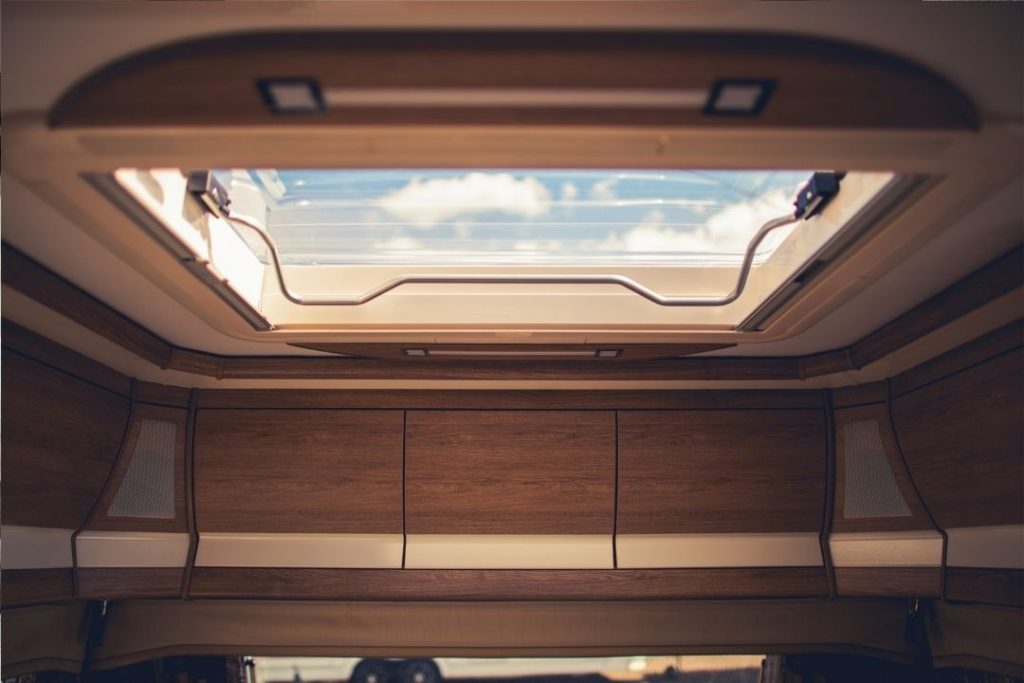
If you have a recessed vent or skylight, consider a vent insulation pillow like this one. These pillows help to keep the warm air in the RV and the cold air out. You’ll want to measure your vent or skylight to make sure you buy the appropriate size. If you don’t have a recessed vent or skylight, you can get a reflective vent cover. We don’t have a recessed vent, so we got the Camco Reflective Vent Cover for our vent fan. It’s also useful to keep the heat out during the summer when you’re not running the vent fan.
Reflective Window Coverings and/or Heavy Drapes
Reflective window coverings can also help insulate the place where you lose the most heat, the windows. Since most RV widows are not a standard size, you can purchase your own roll of reflective window covering to create your own window covers. Reflective foam is also a good RV window insulator. If you have a standard-sized window on your RV door, a reflective window cover is good for that.
If your RV has heavy drapes, you have an advantage. You can also add the reflective window covering in addition to the drapes, or try camping with just the drapes to see how comfortable they keep your camper.
Floor Insulation/RV Skirt
Heat will dissipate from your RV floor and there are some ways to prevent some heat loss. Carpet, rugs and foam board flooring can be used to help with heat loss through the floor. I’ve seen people use the click-together foam tiles in their RVs.
If you’re doing some longer-term RV camping (like visiting relatives for the holidays), consider an RV skirt. An RV skirt can be fabric, wood, foam boards, or even hay bales. An RV skirt will trap the heat from your RV floor and prevent it from dissipating as quickly.
Electric Blankets/Heating Pads
At night, I like to keep our RV cool, but I like to sleep warm. In cold weather, I use a 12-volt electric heating blanket, like this one, that I can run off the Jackery or the battery. It does take a little while to warm up, so I get it going before I get in bed so I’ll be toasty. Another option is a 12-volt heating pad. You can place it near your feet or where ever feels best for you.
Insulated, Heated Hoses
If you want to have access to water, whether you are in a campground with hookups, or at a friend’s home, you’ll need insulated and heated hoses for cold-weather camping. The Camco TASTEPure Heated Drinking Water Hose is a good option up to a point. It comes in several lengths and two temperature ratings.
It’s also important to insulate the spigot. You can use foam insulation and heat tape on external plumbing. Be sure to slow drip your faucets during freezing temperatures.
As an alternative to heated hoses, use the water in your tank. You can fill the freshwater tank periodically. Likewise, keep your wastewater valve closed until you are ready to dump. After you dump, make sure the hose is empty so you don’t end up with a poopsicle. It’s a little more work that way, but it can save you some money.
RV Antifreeze
To help keep your holding tanks from freezing, add a little RV antifreeze to both the grey and black tanks.
Insulation for Stabilizer Jacks
To keep your stabilizer jacks from freezing to the concrete, place a block of wood underneath them.
Proper Clothing
Half the fun of RV camping is getting outside. And when it’s cold outside, you’ll want to have the proper clothing. You’ll want to have a good jacket, a hat, gloves, and warm socks. In my opinion, a down jacket is the best way to go. I have the Marmot Hype 800 fill jacket with a hood. I love it. I can still wear a warm hat with it. You can also get a down coat if you are really averse to the cold. If it’s snowing you’ll also want a Gortex jacket to keep your down jacket dry.
Another important clothing item for the cold is a good hat. My husband has an Outdoor Research Whitefish Hat that he really likes because it has ear muffs and is wind and waterproof.
I like fleece gloves so I can move my hands, but if you’re out for a while, you may want some heavier winter gloves.
We both love Darn Tough socks. They are durable and warm, but a little pricey. My husband has these Merino Wool Boot Socks that he wears in cold weather. I’m partial to wool. I think it performs better than synthetics when it comes to socks. I also like Smartwool socks.
An underlayer will keep you toasty. I have a Smartwool base layer, which is warm and super comfortable. And it’s always good to wear layers so you can take them off and get comfortable when you get back in the RV.
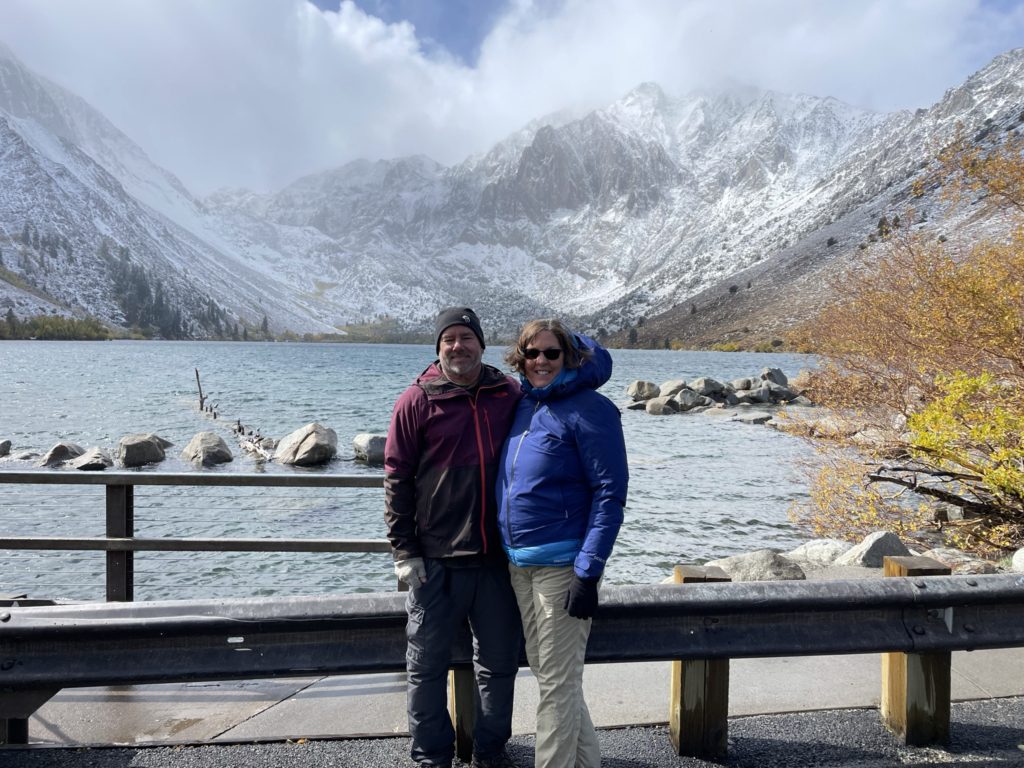
Hand/foot warmers
It’s crazy to think that you can actually buy heated clothing! This is something marketed to hunters since they spend long periods of time in the cold. For the amount of time I’m outside in the cold, hand/foot warmers work for me. These warmers are chemically activated and last for several hours.
Can You Live Full-time in an RV in Winter?
Many people live in a camper full-time in the winter. Some of them are snowbirds, who migrate South from Northern regions, like Canada. When the borders closed, Canadian full-time campers had to make some special adaptations for camping in cold weather, much like I’ve described in this article.
How to Keep RV Pipes from Freezing While Camping?
If you plan on camping in locations where it commonly freezes, you’ll want to make take some precautions with your RV.
- Check Your Propane Levels
- Keep the Water Heater ON
- Check Your House Batteries
- Add Antifreeze to Waste-water tanks
- Camp in a Sunny Spot
- Open Cabinet Doors
- Use Freshwater On Board
- Close Waste Water Valve
- Use RV Skirting
- Install Tank Heaters
Conclusion
With the proper preparation, you can make your cold-weather camping stay much more enjoyable.
